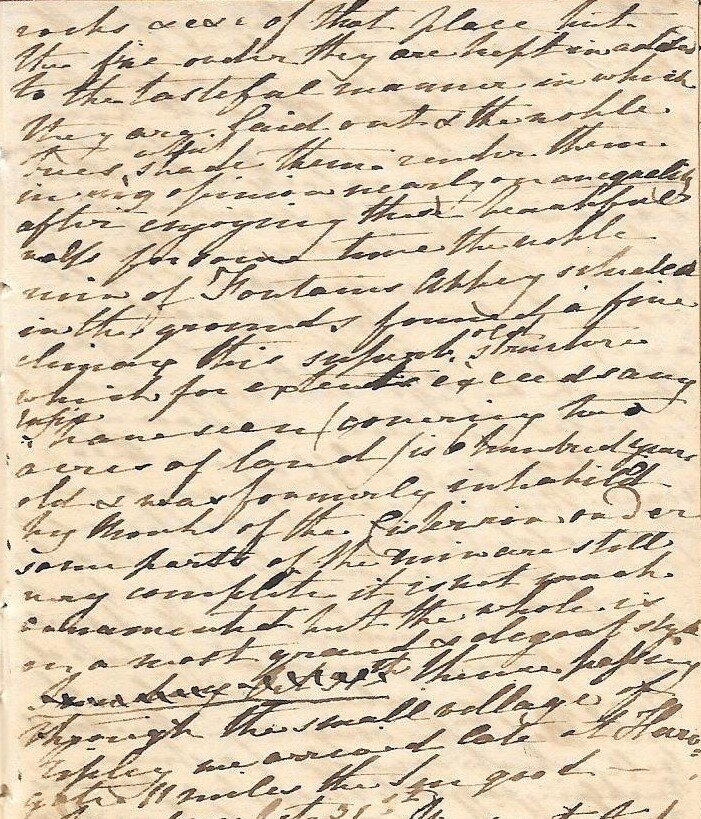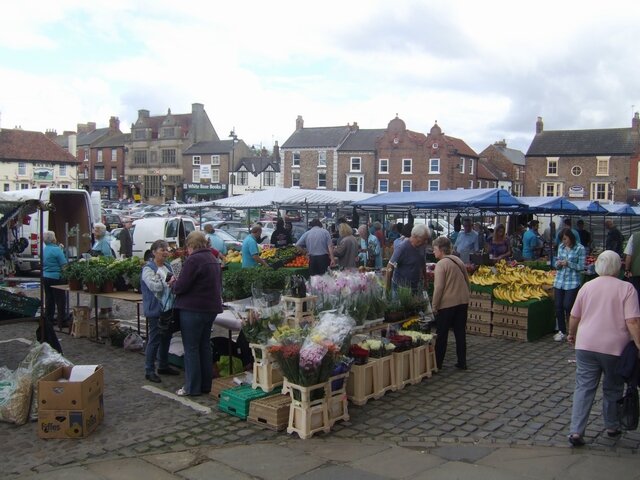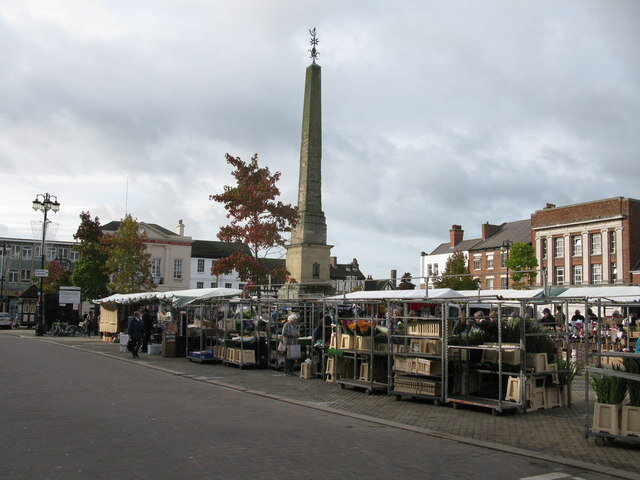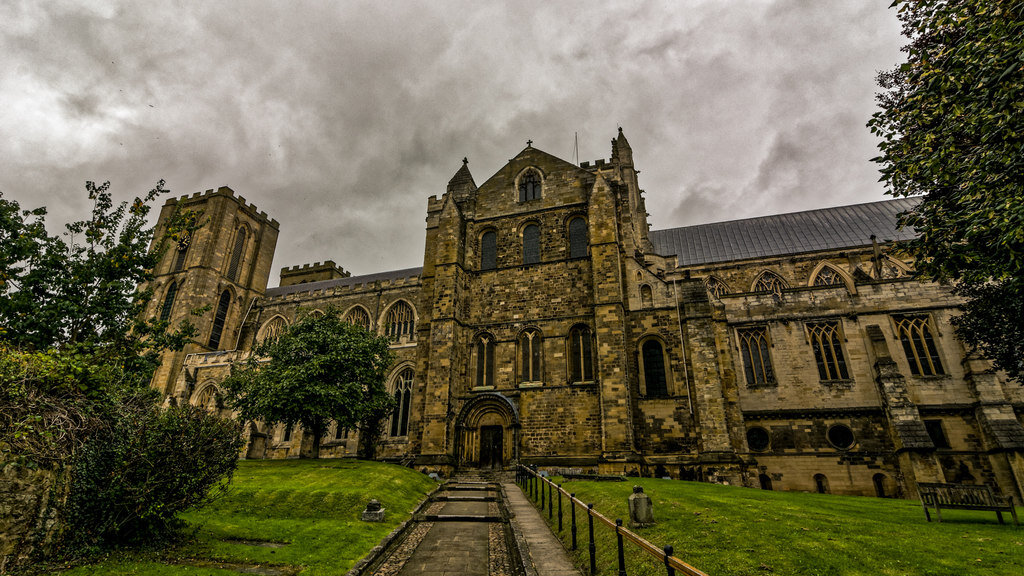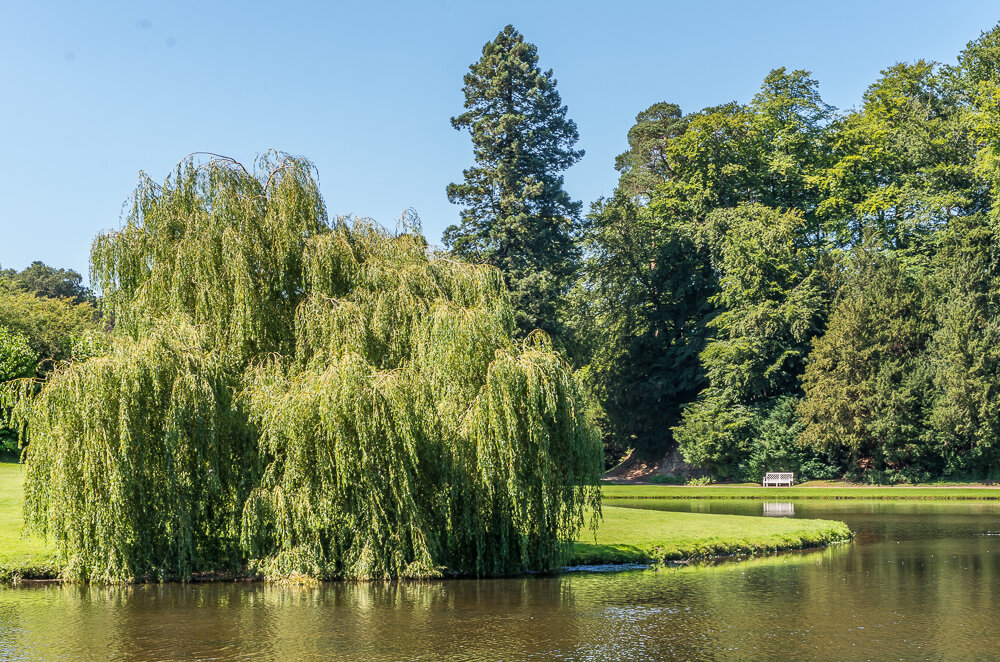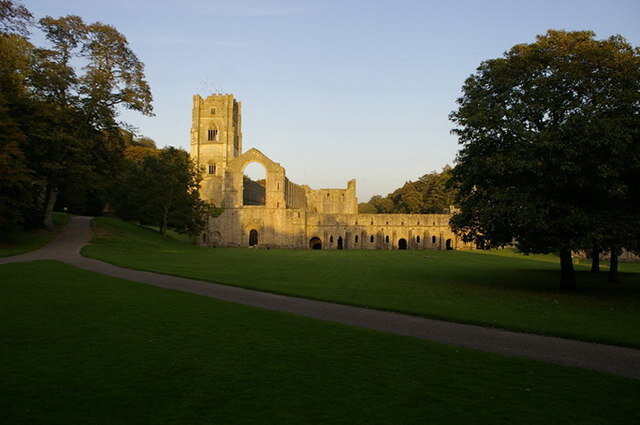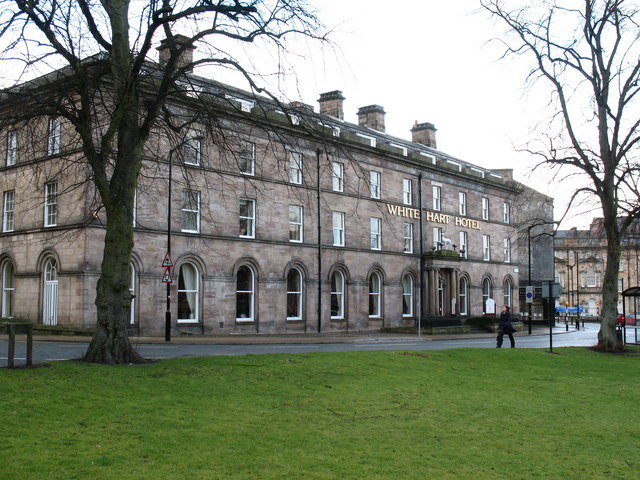Saturday 30th October 1819
Saturday Oct 30th we left Northallerton & went to Thirsk to breakfast 9 miles the town is pretty & the Inn good we then rode two miles to a very pretty village called Sorby where we saw the house where my father went to school nearly 40 years ago. We then proceeded to Rippon 11 miles Rippon Minster standing on an eminence close to the town is a fine building; changing horses we went a mile & a half to Studley Park the seat of Miss Lawrence the house is not shown but after riding through a most beautiful park we arrived at the pleasure grounds they are (Dunkeld excepted) the most beautiful I have ever witnessed they certainly cannot boast of the fine views
rocks &c. of that place but the fine order they are kept in added to the tasteful manner in which they are laid out & the noble trees which shade them render them in my opinion nearly on an equality After enjoying these beautiful walks for some time the noble view of Fountains Abbey situated in the grounds formed a fine climax this superb old structure which for extent exceeds any ruin I have seen (covering two acres of land) is 6 hundred years old & was formerly inhabited by monks of the Cistercian order some parts of the ruin are still very complete it is not much commented but the whole is on a most grand & elegant style thence passing through the small village of Ripley we arrived late at Harrogate 11 miles the Inn is good
OBSERVATIONS & COMMENTS:
Thirsk is built around a large medieval market square, which still hosts an open-air market.
Thirsk Market .Thriving Saturday market. © Copyright John M and licensed for reuse under the (CC BY-SA 2.0) Creative Commons Licence. https://www.geograph.org.uk/photo/2010361
The market was established in 1145 and is the focal point for local farmers, traders and visitors. The town was once known for its leather tanning and saddlery trade, but this was replaced in the 19th century by the production of farming implements. https://en.wikipedia.org/wiki/Thirsk
Inn: The Golden Fleece Hotel retains structures dating from the 1500s, including a large, oak-beamed, inglenook fireplace.
The Golden Fleece, Thirsk . © Copyright Bill Boaden and licensed for reuse under the (CC BY-SA 2.0) Creative Commons Licence. https://www.geograph.org.uk/photo/2697769
It is thought to have originated as a private house. It came to prominence as an inn in 1810 when new owners George and Mary Blythe established it as one of the north’s most important coaching inns. https://www.goldenfleecehotel.com/the-hotel/history/ Another Inn at the time was the Three Tuns: Around 1740, the Dower House, in the Market Place, was adapted for use as a coaching inn.
Ye Olde Three Tuns, Finkle Street . A 13th Century Coaching Inn, & the oldest pub in Thirsk. It is rumoured that Dick Turpin was sighted here. © Copyright Stephen Armstrong and licensed for reuse under the (CC BY-SA 2.0) Creative Commons Licence. https://www.geograph.org.uk/photo/2590850
At that time, it was Thirsk’s only coaching inn and had the monopoly for many years. The London, Edinburgh, Newcastle, Leeds and Darlington coaches all used the Three Tuns Hotel for bed and breakfast. The original mangers, stalls and hay lofts for the horses may still be seen at the yard, behind the pub. https://www.jdwetherspoon.com/pub-histories/england/north-yorkshire/the-three-tuns-thirsk
Sowerby is a small village, situated immediately south of Thirsk.
Sowerby Main Street © Copyright Paul Buckingham and licensed for reuse under the (CC BY-SA 2.0) Creative Commons Licence. https://www.geograph.org.uk/photo/1468243
The educationalist, John Rowntree, father of York-based cocoa and chocolate manufacturer Joseph Rowntree, was educated at a Quaker school in the village. https://en.wikipedia.org/wiki/Sowerby,_North_Yorkshire
School: Although John Rowntree was educated at Sowerby, it was a Quaker school and the Copland’s were avowedly Church of England. No other school can be found for Alexander Copland, born 1774, who attended a school there “nearly 40 years ago” i.e. before 1779, and would have been around 4 years old at the time. However, he may have remained there until he was bound to Richard Holland “surveyor” in November 1784 aged 10, about 35 years earlier http://www.oxforddnb.com/view/10.1093/ref:odnb/9780198614128.001.0001/odnb-9780198614128-e-49436
Ripon: It's proximity to Fountains Abbey, where the Cistercians had a long tradition of sheep farming and owned much grazing land, was a considerable advantage. After English people were forbidden from wearing foreign cloth in 1326, Ripon developed a cloth industry which was third in size in Yorkshire after York and Halifax.
1821: Ripon, Yorkshire by Francis Nicholson. http://www.rareoldprints.com/z/6975
Ripon replaced its old textiles industry with one for the manufacture of spurs during the 16th century. They were so widely known that they gave rise to the proverb "as true steel as Ripon Rowels". At the time, spurs did not just serve as functional riding accessories, they were also fashionable; an expensive pair was made for King James I when he stayed at Ripon in 1617. The Ripon Obelisk was designed by Nicholas Hawksmoor it was erected by the town council in 1702 to commemorate the Ripon Hornblowers who date back to the reign of King Alfred in 886.
1860: Market Place, Ripon , from Book: (24) Views of Ripon & Neighbourhood, Engraver: Rock & Co http://www.rareoldprints.com/z/7578
Ripon Market and Obelisk, Market Place, Ripon . Ripon Market takes place every Thursday in the city's Market Place, with stalls opening from about 9.00am to 4.00pm. © Copyright G Laird and licensed for reuse under the (CC BY-SA 2.0) Creative Commons Licence. https://www.geograph.org.uk/photo/5568729
During the Georgian era Ripon, unlike several other cities, was not significantly affected by the Industrial Revolution despite the existence of various guilds. https://en.wikipedia.org/wiki/Ripon
The Unicorn reborn. © Copyright Stephen Craven and licensed for reuse under the (CC BY-SA 2.0) Creative Commons Licence. The Unicorn Hotel on Ripon Market Square was closed in 2010. It has now been reopened by J D Wetherspoon. Listed grade 2, it is described as a former coaching inn or "posting house", dating from the 18th century with an early 19th century top floor. https://www.geograph.org.uk/photo/4953138
Rippon Minster, the Church of St Peter and St Wilfrid was founded as a monastery by Scottish monks in the 660s, and refounded as a Benedictine monastery by St Wilfrid in 672. The crypt dates from this period. The present church is the fourth, and was built between the 13th and 16th centuries.
1790: South View of Ripon Minster. Artist: W H Wood, Engraver: F Birnie, Publisher: W H Wood, Ripon http://www.rareoldprints.com/z/6969
Ripon Cathedral © Copyright Peter Moore and licensed for reuse under the (CC BY-SA 2.0) Creative Commons Licence. https://www.geograph.org.uk/photo/5138795
The east window was built as part of a reconstruction of the choir between 1286-8 and 1330, and was described by architecture critic Pevsner as a 'splendid' example of the series of large Decorated gothic windows constructed in Northern England. The church's thirty-five misericords were carved between 1489 and 1494.
Choir, Ripon Cathedral, Yorkshire, from Book: (24) Views of Ripon & Neighbourhood, Engraver: Rock & Co http://www.rareoldprints.com/z/7572
Ripon Cathedral . View west in Ripon Cathedral Quire © Copyright Richard Croft and licensed for reuse under the (CC BY-SA 2.0) Creative Commons Licence. https://www.geograph.org.uk/photo/5377219
In 1836 the church became the cathedral for the Diocese of Ripon https://en.wikipedia.org/wiki/Ripon_Cathedral
Studley Royal Park including the ruins of Fountains Abbey is a designated World Heritage Site that features an 18th-century landscaped garden, some of the largest Cistercian ruins in Europe, a Jacobean mansion and a Victorian church designed by William Burges. It was developed around the ruins of the Cistercian Fountains Abbey. John Aislabie, the Tory Member of Parliament for Ripon in 1695 and in 1718 Chancellor of the Exchequer, was a principal sponsor of the South Sea Company scheme, the bill for which was promoted by him personally.
1852: Temple of Fame, Studley Park. Engraver: Rock & Co http://www.rareoldprints.com/z/2234
1866: Studley Royal, Yorkshire. From the Octagon Tower. From Book: (24) Views of Ripon & Neighbourhood Engraver: Rock & Co http://www.rareoldprints.com/z/7580
1861: Avenue, Studley Park, with Ripon Minster & the Wolds. From Book: (24) Views of Ripon & Neighbourhood Engraver: Rock & Co http://www.rareoldprints.com/z/7589
1866: Avenue in the Deer Park, Studley Park, Yorkshire. From Book: (24) Views of Ripon & Neighbourhood Engraver: Rock & Co http://www.rareoldprints.com/z/7592
In 1720 when this vast financial operation collapsed, he was expelled from Parliament and disqualified for life from public office. Aislabie returned to Yorkshire and devoted himself to the creation of the garden he had begun in 1718. After his death in 1742, his son William extended his scheme by purchasing the remains of the Abbey and Fountains Hall. He extended the landscaped area in the picturesque romantic style, contrasting with the formality of his father's work.
The Surprise View, Studley Royal. The so called Surprise View at Studley Royal, with Fountains Abbey in the background. It was called the Surprise View because visitors would have been led along the High Ride (north from here) among trees, with the view of the Abbey suddenly opening up in front of them from this point. In the foreground is Half Moon Pond, formed from the deepening and widening of the River Skell. © Copyright Ian Capper and licensed for reuse under the (CC BY-SA 2.0) Creative Commons Licence. https://www.geograph.org.uk/photo/2835933
Studley Royal . Wonderful autumn colours. © Copyright Anna and licensed for reuse under the (CC BY-SA 2.0) Creative Commons Licence. https://www.geograph.org.uk/photo/4742670
Studley Royal . The stepping stones and walkway reset and open for business. © Copyright Simon Huguet and licensed for reuse under the (CC BY-SA 2.0) Creative Commons Licence. https://www.geograph.org.uk/photo/844713
Half Moon Pond . A Weeping Willow on the bank of the Half Moon Pond in the Water Garden at Studley Royal. The water garden at Studley Royal is one of the best surviving examples of a Georgian water garden in England. The garden was created by John Aislabie in 1718. The estate of Fountains Abbey and Studley Royal is a UNESCO heritage site. © Copyright Ian Capper and licensed for reuse under the (CC BY-SA 2.0) Creative Commons Licence. https://www.geograph.org.uk/photo/5472323
Between them, the two created what is arguably England's most important 18th century Water Garden. and erected the obelisk (designed by Nicholas Hawksmoor). https://en.wikipedia.org/wiki/Studley_Royal_Park
Miss Lawrence: After William Aislabie's death, the estate passed to his daughter Elizabeth Allanson and then to her niece, Mrs Elizabeth Sophie Lawrence, who lived there from 1808 until her death in 1845.
Fountains Abbey is one of the largest and best preserved ruined Cistercian monasteries in England. It is located approximately 3 miles (5 kilometres) south-west of Ripon in North Yorkshire, near to the village of Aldfield. Founded in 1132, the abbey operated for 407 years becoming one of the wealthiest monasteries in England. In the second half of the 13th century the abbey was in more straitened circumstances. It was presided over by eleven abbots, and became financially unstable largely due to forward selling its wool crop, and the abbey was criticised for its dire material and physical state when it was visited by Archbishop John le Romeyn in 1294. The run of disasters that befell the community continued into the early 14th century when northern England was invaded by the Scots and there were further demands for taxes. The culmination of these misfortunes was the Black Death of 1348–1349. The loss of manpower and income due to the ravages of the plague was almost ruinous.
1809: Fountains - Abbey in Yorkshire, from John Buckler's Cathedrals. Artist: John Buckler. Engraver: Richard Reeve. Publisher: J.Buckler, Bermondsey, Surrey http://www.rareoldprints.com/z/2526
Fountains Abbey © Copyright David Dixon and licensed for reuse under the (CC BY-SA 2.0) CreativeCommons Licence. https://www.geograph.org.uk/photo/2538024
1825: Fountains Abbey, Yorkshire. Drawn by J. Smith Esqr. Publisher: R Bowyer, Pall Mall From: A Selection of Fac-Similes of Water-Colour Drawings, from the Works of the Most Distinguished British Artists 1825 http://www.rareoldprints.com/z/14824
Fountains Abbey . © Copyright Alexander P Kapp and licensed for reuse under the (CC BY-SA 2.0) Creative Commons Licence. https://www.geograph.org.uk/photo/2657090
It was dissolved in 1539 under the order of Henry VIII and the Abbey buildings and over 500 acres (200 ha) of land were sold by the Crown, on 1 October 1540, to Sir Richard Gresham who had supplied Cardinal Wolsey with the tapestries for his new house of Hampton Court and who paid for the Cardinal's funeral. Gresham sold some of the fabric of the site, stone, timber, lead, as building materials to help to defray the cost of purchase. The site was acquired in 1597 by Sir Stephen Proctor, who used stone from the monastic complex to build Fountains Hall. Between 1627 and 1767 the estate was owned by the Messenger family who sold it to William Aislaby who was responsible for combining it with the Studley Royal Estate. https://en.wikipedia.org/wiki/Fountains_Abbey
Ripley is a village a few miles north of Harrogate. A castle dating from the 15th century, Ripley Castle, has been the home of the Ingilby family for 700 years. The castle, which has a priest hole, is open for public tours.
circa 1880: Ripley Castle Baxter print, Source http://www.digitalengravings.com/ Author Rev. Francis Orpen Morris. This image is in the public domain due to its age. Rev Morris died in 1893 https://commons.wikimedia.org/wiki/File:Ripley_CastleDE.jpg
Ripley Castle . Ripley Castle is a large country house in Ripley about 3 miles north of Harrogate. It dates from the 14th century with later additions mainly in the 16th and 18th centuries. The house was built using coursed squared gritstone and ashlar. Ripley Castle is a Grade I listed building. This view is looking across Ripley Lake. © Copyright G Laird and licensed for reuse under the (CC BY-SA 2.0) Creative Commons Licence. https://www.geograph.org.uk/photo/5754027
The landscaped castle grounds and ornamental lakes are also open to the public. A 19th century Ingilby tore down the old village and modelled it after an Alsatian village with an "hôtel de ville" style town hall.
Main Street, Ripley . The view from the Harrogate-bound bus stop. Both terraces, part of the estate village for Sir William Amcotts Ingilby, are listed. © Copyright Derek Harper and licensed for reuse under the (CC BY-SA 2.0) Creative Commons Licence. https://www.geograph.org.uk/photo/4118851
The castle and the parish church were not affected by the reconstruction. https://en.wikipedia.org/wiki/Ripley,_North_Yorkshire
Harrogate: It's development is owed to the discovery of its chalybeate and sulphur rich spring water from the 16th century. The first mineral spring was discovered in 1571 by William Slingsby who found that water from the Tewit Well in High Harrogate possessed similar properties to that from springs in the Belgian town of Spa, which gave its name to spa towns. The medicinal properties of the waters were publicised by Edmund Deane.
1855: High Harrogate . Engraver: Rock & Co http://www.rareoldprints.com/z/3831
His book, Spadacrene Anglica, or the English Spa Fountain was published in 1626. In the 17th and 18th centuries further chalybeate springs were discovered in High Harrogate, and both chalybeate and sulphur springs were found in Low Harrogate.
1853: Low Harrogate. Engraver: Rock & Co http://www.rareoldprints.com/z/3834
The two communities attracted many visitors.
Central Harrogate, North Yorkshire © Copyright Steven Haslington and licensed for reuse under the (CC BY-SA 2.0) Creative Commons Licence. https://www.geograph.org.uk/photo/2869556
A number of inns were opened for visitors in High Harrogate in the 17th century (the Queen's Head, the Granby, the Dragon and the World's End.) In Low Harrogate the Crown was open by the mid-18th century, and possibly earlier. To provide entertainment for the increasing numbers of visitors the Georgian Theatre was built in 1788. https://en.wikipedia.org/wiki/Harrogate
Inns in 1819: The Crown Hotel’s history dates back over 300 years, alongside an enviable location just moments from many of Harrogate’s most popular sites. https://www.bespokehotels.com/thecrownhotel The present hotel is a rebuild from 1847.
The Crown Hotel, Harrogate . The has been a Crown Hotel here since shortly after the Restoration, but this building only started in 1847, and the tower on the right only dates to 1900. © Copyright Keith Edkins and licensed for reuse under the (CC BY-SA 2.0) Creative Commons Licence. https://www.geograph.org.uk/photo/1197656
The Granby: Situated on the edge of The Stray, Harrogate’s historic parkland, The Granby Care Home is based within easy reach of the town’s shops, tearooms, restaurants and amenities. This impressive, eighteenth-century former hotel – which offers en suite bedrooms, a library, a cinema and a beautiful Crystal Ballroom. https://www.brighterkind.com/care-homes/the-granby
The Granby, Harrogate . The Granby was once one of Harrogate's premier hotels, particularly in the late 18th and 19th centuries when the wells of High Harrogate were popular. The first inn on this site was the 'Sinking Ship' in the 17th century. This was rebuilt and renamed as the Granby in 1795, being named after the Marquis of Granby who had distinguished himself during the seven years war. The hotel was always popular with the nobility [see also the nearby Cedar Court hotel], and amongst those who stayed here was Clive of India. The hotel went into a gradual decline after WW2 as it was at the wrong end of town. After recent refurbishment it became apartments for the retired and a care home. © Copyright Gordon Hatton and licensed for reuse under the (CC BY-SA 2.0) Creative Commons Licence. https://www.geograph.org.uk/photo/656791
THE DRAGON HOTEL was demolished in the late Victorian/ Edwardian period. The unveiling of W P Frith’s commemorative plaque “began with a short stroll to nearby Christ Church, where Frith’s father, Thomas, was one of the first church wardens and there resides another plaque dedicated to the Frith family.” THIS IS LIKELY TO HAVE BEEN WHERE LUCY STAYED, close to the church they attended the next morning. Read more at: https://www.harrogateadvertiser.co.uk/news/frith-s-birthplace-marked-with-plaque-1-2720460 .
The Old Swan Hotel, Harrogate © Copyright Keith Edkins and licensed for reuse under the (CC BY-SA 2.0) Creative Commons Licence. https://www.geograph.org.uk/photo/1197866
One possibility was The Swan Inn https://en.wikipedia.org/wiki/Old_Swan_Hotel and another the White Hart Hotel https://en.wikipedia.org/wiki/White_Hart_Hotel,_Harrogate
The White Hart Hotel . One of Harrogate's oldest hotels, dating back at least as far as the 18th century when it was a coaching inn. The hotel was in just the right place when Low Harrogate developed as a spa, being barely a minutes walk from the sulphur well. In 1815 there was a spectacular 'Waterloo Ball' as which there was 'an unusual assemblage of beauty and fashion'. The present building dates from an 1847 rebuild and has been described by Pevsner as 'the best building in Harrogate'. For many years during the 20th century it was used as a hospital, but has now been returned to its former status as a top class hotel. © Copyright Gordon Hatton and licensed for reuse under the (CC BY-SA 2.0) Creative Commons Licence. https://www.geograph.org.uk/photo/657894
Can you help us?
Old Regency Prints, Pictures an Coaching maps: Do you have access to any prints or pictures showing what town and country would have looked like when Lucy travelled through? Any illustrations of what she would have seen in 1819 will enliven our research.
New Pictures: Do you have any modern pictures of the streets, buildings, gardens and views that would enable us to see the changes that two centuries have wrought?

